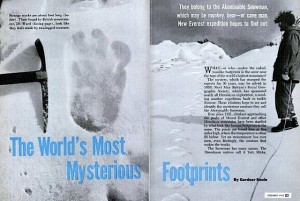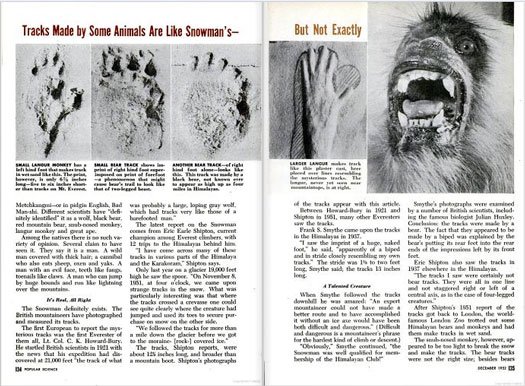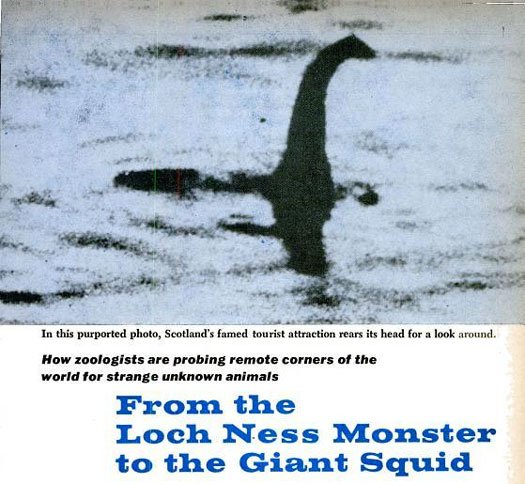May 21, 2011
![]()
The popular culture, cutting edge blog Boing Boing has a diversity of opinions, but recently one of their bloggers went a little too far. This recent moment of less-than-grounded demeaning was thanks to throwaway comments from their science editor, a blogger named Maggie Koerth-Baker. She definitely appears to have gone over the edge, dropping the “pseudoscience” bomb on cryptozoology. Let us explore this business, and begin by illuminating a few things.

Needless to say, my knowledge as to what others think, of course, is not because I am an omnipotent seer. I have no idea why a few (I do not think it is most) people would associate cryptozoology with the word “pseudoscience.” Bernard Heuvelmans, Ivan T. Sanderson and many of my peers and I have made great strides in educating the general public about the realistic parameters of cryptozoology. I find the modern media and especially the online and electronic communities, like Boing Boing, infrequently mix everything up. Boing Boing certainly supports aware and solid bloggers, David Pescovitz and Mark Frauenfelder, who most certainly understand cryptozoology, its place in science and popular culture. But then there’s Maggie Koerth-Baker.

As opposed to getting frustrated, the appearance of Koerth-Baker’s recent blog merely means I need to try harder to be clearer in what I say, educate more, and spread critical thinking within the cryptozoological works I produce.
Most of the time, I do not waste my time getting defensive and doing battle with people who wish to label cryptozoology as a “pseudoscience.” Their minds seem to be usually already made up about how they wish to categorize my field, and I would rather be doing cryptozoology than trying to convince someone it is not something it isn’t.
Nevertheless, oftentimes, we must point out transgressions that appear to be beyond the pale. It does get troubling that even well-meaning people can so blindly slam an entire group of scientifically, skeptically-minded folks with demeaning categorizations that have little or no foundation in fact.


Therefore, for the purposes of criticism, allow me to share what Koerth-Baker wrote:
The Popular Science archives—Google-digitzed versions of whole issues stretching back to the beginning of the 20th century—will never not be awesome. Reading these magazines can teach you a lot about the culture and history of science. It’s also a nice way for journalists, like me, to remind ourselves about how very easy it is to get our jobs wrong.
For instance, just because the Royal Geographic Society is sending an expedition to the Himalayas to hunt for the Abominable Snowman doesn’t mean the Abominable Snowman definitely exists. In this story, from a gallery of Pop Sci articles about pseudoscience (some appropriately skeptical, some … not), it’s easy to see the writer getting so caught up in the excitement of the hunt that he stopped questioning whether there was really anything to hunt for. It’s a fun read. And a nice kick in the pants.

The Popular Science writer of this December 1952 (!) article got it “wrong,” according to this Boing Boing blogger. The writer Gardner Soule (a well-known cryptozoology historian) got “so caught up in the excitement of the hunt that he stopped questioning whether there was really anything to hunt for,” writes Koerth-Baker.
Oh really? How are we to know if there are no Yetis out there (in 1952!) if no one was willing to test the hypothesis, based on Native folklore, traditions, artifacts, and solid evidence, that the Abominable Snowmen and Snowwomen might be out there? Why equate the word “pseudoscience” and “skeptical”? Clearly, Koerth-Baker is the writer here who has it wrong.
The simple fact is, the body of cryptozoology is not pseudoscience. There is a very large amount of testable physical evidence in the field of cryptozoology, and testing physical evidence is science, not Maggie Koerth-Baker’s “pseudoscience.”
Let me call upon some skeptics who have written about cryptozoology and pseudoscience via exchanges of the past here at Cryptomundo to check in on this matter.
Speaking of the tendency of some to lump cryptozoology in the dustbin of “pseudoscience,” science writer Matt Bille argues that, even if one thinks “cryptozoology is worthless in practice, it still does not belong there. The reason is that cryptozoology is a true science because it is based on falsifiable hypotheses.” (Update: See also here.)
Ben Radford, deputy editor of The Skeptical Inquirer, once commented at Cryptomundo, “I don’t consider cryptozoology a pseudoscience, nor paranormal. Our organization doesn’t just focus on paranormal topics, we cover fringe science, quack medicine, critical thinking, miracles, etc. So I’d say we agree on this.”
DWA, demonstrating a bit of the anger that cryptozoological fans often flash, once wrote: “The folks who have confirmed skeptics like me questioning the pat mainstream assumption that cryptids don’t exist are people who assemble observations, search for commonalities, perform statistical analyses, and posit sound hypotheses. Sounds like science. The ones who can’t convince me they’re right are the ones who click heels three times and crow: PSEUDOSCIENCE! Their attitude seems best exemplified by another legendary primate, or more precisely three of them: the trio whose hands conveniently cover sensory orifices to prohibit entry or exit of anything – like fact – that makes them uncomfortable.”
Writer Sergio penned this, “It’s so easy to dismiss things or people with a wave of the hand and say, ‘Bah pseudoscience!’ All hypotheses start with a basic premise. The premise is what impels the further investigation to refute or support the hypothesis.”
Daniel Loxton, editor of Junior Skeptic, correctly points out that we should be careful of throwing around words like “pseudoscience.” He wrote: “Cryptozoology is not, strictly speaking, ‘paranormal.’ At least at its best, it is also not pseudoscientific. Looking for unrecognized species is, in itself, a perfectly respectable, mainstream scientific pursuit….When skeptics lump cryptozoology in with paranormal topics like ESP and ghosts, we’re not using language in a precise way. This is just a casual short-hand that reflects pop culture convention and the fact that there is great overlap between proponents of each of these topics.”
I’m afraid that Maggie Koerth-Baker does not “get it.”
Cryptozoology is the study of “hidden animals;” that is the examination and investigation of reported living animals that Western Science may find to have been labeled as recently extinct, never extinct, or merely new species. But also the work of cryptozoology is to discover if the reported animals are merely misidentifications, mistakes, and in very rare cases (less than 1%) hoaxes. When and where did Koerth-Baker miss the point that you don’t find animals if you don’t look for them? Or that cryptozoologists are not also skeptical of the majority of such sightings and presented evidence?
As to the two Gardner Soule articles that Koerth-Baker directly (from 1952) and indirectly (from 1961), points to, one on Yeti and the other being a survey of what cryptozoological topics are being pursued, the Popular Science treatment appears to meet the goal of the writer, of course, which was a popular science news update of a cryptozoological hunt and a good overview of the cryptids. It is unfortunate that Koerth-Baker (and the current editors of PS, apparently) found it necessary to use these old Soule pieces as another opportunity to dismiss the science of cryptozoology!
About Loren Coleman
Loren Coleman is one of the world’s leading cryptozoologists, some say “the” leading living cryptozoologist. Certainly, he is acknowledged as the current living American researcher and writer who has most popularized cryptozoology in the late 20th and early 21st centuries.
Starting his fieldwork and investigations in 1960, after traveling and trekking extensively in pursuit of cryptozoological mysteries, Coleman began writing to share his experiences in 1969. An honorary member of Ivan T. Sanderson’s Society for the Investigation of the Unexplained in the 1970s, Coleman has been bestowed with similar honorary memberships of the North Idaho College Cryptozoology Club in 1983, and in subsequent years, that of the British Columbia Scientific Cryptozoology Club, CryptoSafari International, and other international organizations. He was also a Life Member and Benefactor of the International Society of Cryptozoology (now-defunct).
Loren Coleman’s daily blog, as a member of the Cryptomundo Team, served as an ongoing avenue of communication for the ever-growing body of cryptozoo news from 2005 through 2013. He returned as an infrequent contributor beginning Halloween week of 2015.
Coleman is the founder in 2003, and current director of the International Cryptozoology Museum in Portland, Maine.
Filed under Breaking News, Conspiracies, Cryptomundo Exclusive, CryptoZoo News, Cryptozoology, Media Appearances, Pop Culture, Reviews